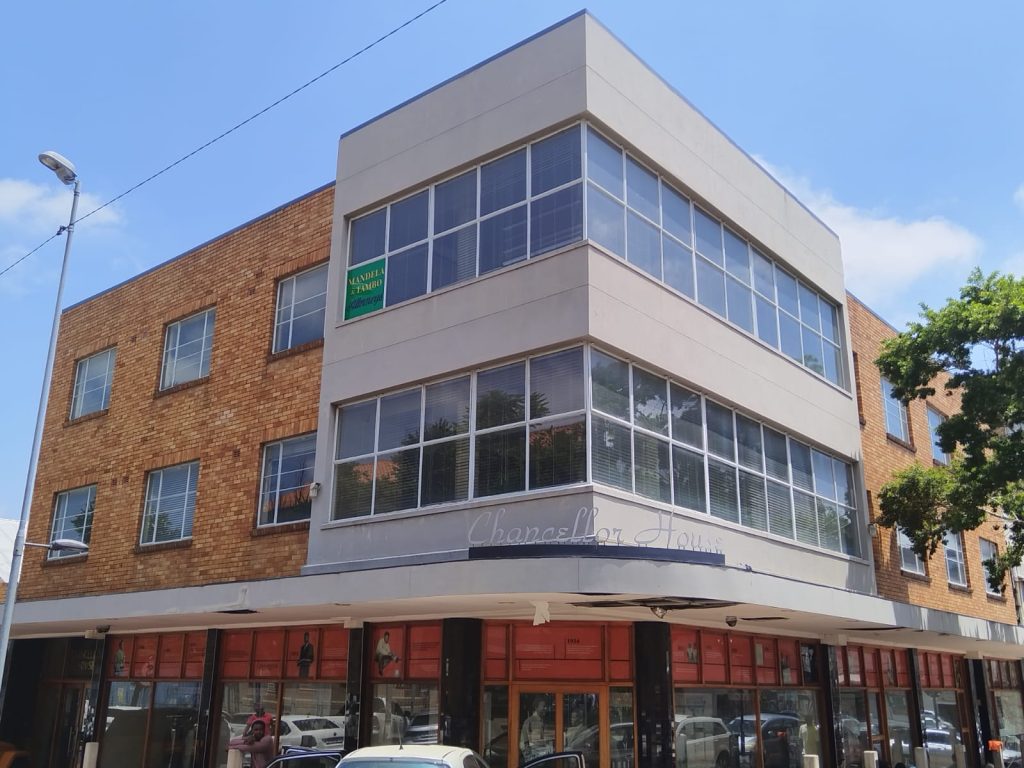Single storey face brick building. The hall formerly served as the printing premises for Bantu World between 1932-1940, the Polly Street Adult Education Centre, and later the Polly Street Art Centre, for which it is predominantly known.
Initially established as the Polly Street Adult Education Centre on 1 July 1949 offering training in painting, weaving, leatherwork, embroidery, house crafts, silkscreen, choir singing and piano tuition, the Polly Street Art Centre rose to prominence in the 1950s as South Africa’s leading arts centre for African artists. According to Elizabeth Rankin the centre occupied what had been a hall for a women’s hostel (original construction date unknown). Initially, the centre focussed on adult education and recreation and had a particularly strong music programme under David Rycroft.
As Esmé Berman writes Polly Street Art Centre was to become "the launching-pad for the first large-scale venture of urban black South Africans into the plastic arts." (Berman 1983: 338).
Polly Street Art Centre is also where celebrated artist Cecil Skotnes worked as teacher and mentor from 1952 to 1965. Skotnes had started out as Assistant Supervisor of Welfare at Jabavu township but quickly accepted the position of Cultural Recreation Officer at the Polly Street Adult Education Centre in mid-1952. Here he worked with Fred Schimmel who had been teaching at the centre from 1949 until around 1957. Other voluntary teachers included Eleanor Lorimor (from the Johannesburg Art Gallery), Mary Duxbury, Emily Fern, Larry Scully (who taught art at Pretoria Boys High School with Walter Battiss) and Gideon Uys. When Skotnes joined the centre he was assisted by Solomon Maqambalala who had learnt calligraphy.
While Skotnes’ association with Polly’s is mostly remembered in terms of the visual arts, he continued the music section initiative by Rycroft, extending the music centre into the Jubilee Centre in Eloff Street. Here he worked with Khabi Mngoma (later Professor of Music at the University of Zululand). The centre would initiate a string orchestra, a music library, the Bantu Musical Festivals and the South African Ballroom Dancing Championship.
Although the Centre quickly attracted students, due to a lack of resources it never operated as a fully functional art school. Despite the limited resources and informal approach favoured by Skotnes, the centre achieved a remarkable output. Former ‘students’ included David Mogano, Ezrom Legae, Louis Maqhubela, Ben Arnold, Sydney Kumalo, Durant Sihlali, Lucas Sithole, John Hlatywayo, Dumile Feni, Pat Mautloa, Moses Tladi and Ephraim Ngatane.
It was through the centre that artists such as Kumalo would work on important church commissions such as at St Martin de Porres in Orlando and St Peter Claver in Kroonstad.
From the late 1950s, Edoardo Villa and Egon Guenther contributed hugely to the development of sculpture particularly fruitful in the case of Kumalo. Kumalo would eventually be appointed Art Organiser in 1958 as assistant to Skotnes. Kumalo would pursue a full-time career as artist in 1964 and Skotnes in 1965. Legae took over from Kumalo and Bill Hart from Skotnes.
While formal classes were important, Sihlali emphasises that the centre became a meeting place and centre where black artists could meet and share ideas on art.
In the late 1950s worsening crime in the area, prompted Skotnes to relocate the centre from Polly Street to the Jubilee Centre in Eloff Street. However, from the early 1960s, Skotnes and Kumalo realised that apartheid authorities would not tolerate the centre’s existence for much longer. This prompted the transfer of equipment to township art centres. The Centre survived until 1970 when it was eventually closed and black artists had to find work at centres at Mofolo and elsewhere.
The art centre was famously visited by Yehudi Menuhin who purchased works from the centre. It is also here that Hugh Masekela gathered with others to receive the trumpet donated by Louis Armstrong.
General Protection: Section 34(1) Structures under the National Heritage Resources Act, 1999

A culmination of research gathered over many years, the Online Johannesburg Heritage Register is being launched on Nelson Mandela Day 18 July 2025.
Among the many heritage sites featured is Chancellor House, the downtown offices of Mandela and Tambo Attorneys in the 1950s. After having been vacant and shuttered for more than a decade, this iconic building is being revived and brought to life once again as offices for the Community Development Department, which oversees the City’s Arts, Culture & Heritage Services.